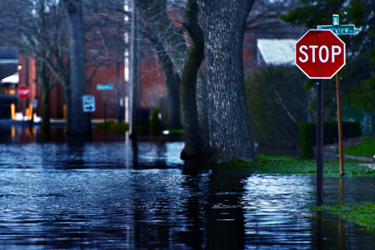Managing Water In The Face Of Natural Disasters
By Jeff McCracken

With resiliency, water scarcity, and cost efficiency top of mind for water utilities, smart water operations come to the fore as an all-of-the-above solution.
Data show extreme weather events are increasing.1 This is challenging utility providers who are managing critical infrastructure around the globe. The year 2020 was truly devastating for wildfires. From California to Australia, the world got a firsthand glimpse into how warmer, drier conditions are causing harsher droughts — resulting in longer fire seasons and greater water scarcity.
Extreme weather makes managing water an even more onerous task, as droughts causing dry and hot weather in the West increase fire danger and limit available resources, and populations continue to grow. Conversely, storm-ravaged parts of the country are dealing with excessive water that threatens to push wastewater systems to their breaking point while also potentially contaminating freshwater systems.
Today’s water utilities can best prepare for either scenario by taking a more active and forward-thinking approach to managing resources.
Managing Water Operations In The Face Of Storms
Hurricanes and tropical storms can cripple water infrastructure facilities. In the wake of Hurricane Katrina in 2005, the U.S. EPA estimated that more than 1,220 drinking water systems2 and more than 200 wastewater treatment facilities in Louisiana, Mississippi, and Alabama had been affected. More than 10 billion gallons of raw and partially treated sewage3 gushed into waterways and bubbled up onto streets and into homes as a result of Hurricane Sandy in 2012.
Restoring damaged facilities and ensuring water safety — from repairing equipment and cleaning sewer lines, to testing for toxic chemicals and bacteria and activating disinfection units, to restoring pressure for water distribution — are time-intensive and costly. The restoration process also involves cleaning and repairing.
While clean, safe potable water is critical, removing millions of gallons of wastewater is vital. Modern technology can help by tying in a wastewater solution to a smart network. Bringing intelligence to the edge, similar to what is happening in the power grid, enables utilities to manage water operations using innovative algorithms and dashboards to manage devices, software, and services holistically. The added intelligence also allows utilities to deliver better services day-to- day by gaining visibility into its network to identify and prioritize leaks and manage service delivery and wastewater treatment.
For utilities, predicting the unpredictable can be a challenge. Digital twin technology is providing promise in this regard. Digital twins are software representations of assets and processes that help understand, predict, and optimize performance to achieve improved business outcomes. Digital twins consist of three components — a data model, a set of analytics or algorithms, and knowledge — and are extremely valuable when it comes to predicting the impact of a storm for sewage and stormwater management.
The first step in creating a digital twin is to simulate the water operations network in a digital replica. Next, develop a data model of normal operations. Then apply knowledge of what we know from previous storms to predict what may happen in a specific scenario.
While a digital twin can help simulate oncoming storms, like forecasting what may be happening, the real value is in the ability to predict future events, understand areas of weakness, and address these all before a storm hits. The ability to identify the aging infrastructure that may be a point of weakness and replace or repair proactively is a key value added by digital twins. This proactive insight prevents emergency repairs and makes regular repairs less costly to manage. It also allows water providers and utilities to develop protocols and scenarios ahead of time to better manage wastewater removal under the worst conditions. When multiple scenarios and potential failures are simulated digitally, artificial intelligence (AI) and machine learning (ML) technology can rapidly learn from these scenarios to provide insights into how to best manage resources when a storm hits.
Managing Water Operations In The Face Of Fires
Water scarcity from drought, hot weather, or other factors is a critical contributor to how we prepare for and manage water operations in fire-prone areas. The Australian wildfires provide a recent example of how drought and growing wildfires can threaten wildlife and humans, as well as their impact on the availability of water overall.
In areas like this, every drop of water counts, as almost one-third of water — 128 million cubic meters of water globally each year — is lost before even reaching a customer. To put this into context, this is about a quarter of the amount of water in Sydney harbor — 562 million cubic meters of water.
Why are we losing so much water? Unfortunately, most of the aquatic utility infrastructure in the U.S. is more than 60 years old, underground, and hard to inspect. Nonrevenue water loss is a big problem and costs $39 billion each year — not counting the other costs due to drought or fires. Regulatory mandates are also driving the need to decrease water loss. How can utilities better protect water resources in times of drought and in the face of the fire season?
Similar to the example above, adding more intelligence4 to water operations systems can provide critical insights to save on water loss. Artificial intelligence and advanced data analytics are providing a better understanding of historical data to generate insights we can use today. Using historical data can help utility providers understand average water usage models and ways to reduce use. Data also allow utilities to engage with customers proactively. Benefits include the ability to flag higher-than-usual water usage earlier to identify potential leaks, as well as to understand potential inefficiencies and reach out to customers to help incentivize changes in usage.
Utility providers can also leverage data to detect leaks in the system by using sensors that can “listen” for the frequency of a water leak. Digging is costly and disruptive. Data analysis can help utility providers reduce costs by fixing leaks before they become an emergency fix (and more expensive). This also allows for the ability to disaggregate water loss. Providers can see potential nefarious water resource theft by looking at a physical loss from leaks.
Conclusion
We must take an active approach to water operations management as we face increases in extreme weather events. There are many challenges utilities face in managing this precious resource, but modern technology is giving us new ways to help predict and control the unpredictable. Adding more intelligence to our water operations network allows forward-thinking utilities to manage resources and minimize risks, while providing a more proactive path to increase operational efficiencies and improve the overall customer experience.
References:
- https://www.sciencedaily.com/releases/2018/03/180321130859.htm
- https://nepis.epa.gov/Exe/ZyPDF.cgi/60001QB5.PDF?Dockey=60001QB5.PDF
- https://www.nytimes.com/2013/05/01/nyregion/hurricane-sandy-sent-billions-of-gallons-of-sewage-into-waterways.html
- https://www.itron.com/na/solutions/who-we-serve/water
About The Author
 Jeff McCracken, director of operations management outcomes, provides global leadership for software and services solutions that incorporate Big Data technology, industry expertise, and advanced algorithms to deliver business intelligence and predictive analytics to Itron’s utility customers. He oversees the discovery and validation of market opportunity and market use cases and drives go-to-market strategy ensuring strategic positioning, allowing the utility to achieve maximum value from its smart grid, smart water, or smart gas investment.
Jeff McCracken, director of operations management outcomes, provides global leadership for software and services solutions that incorporate Big Data technology, industry expertise, and advanced algorithms to deliver business intelligence and predictive analytics to Itron’s utility customers. He oversees the discovery and validation of market opportunity and market use cases and drives go-to-market strategy ensuring strategic positioning, allowing the utility to achieve maximum value from its smart grid, smart water, or smart gas investment.
